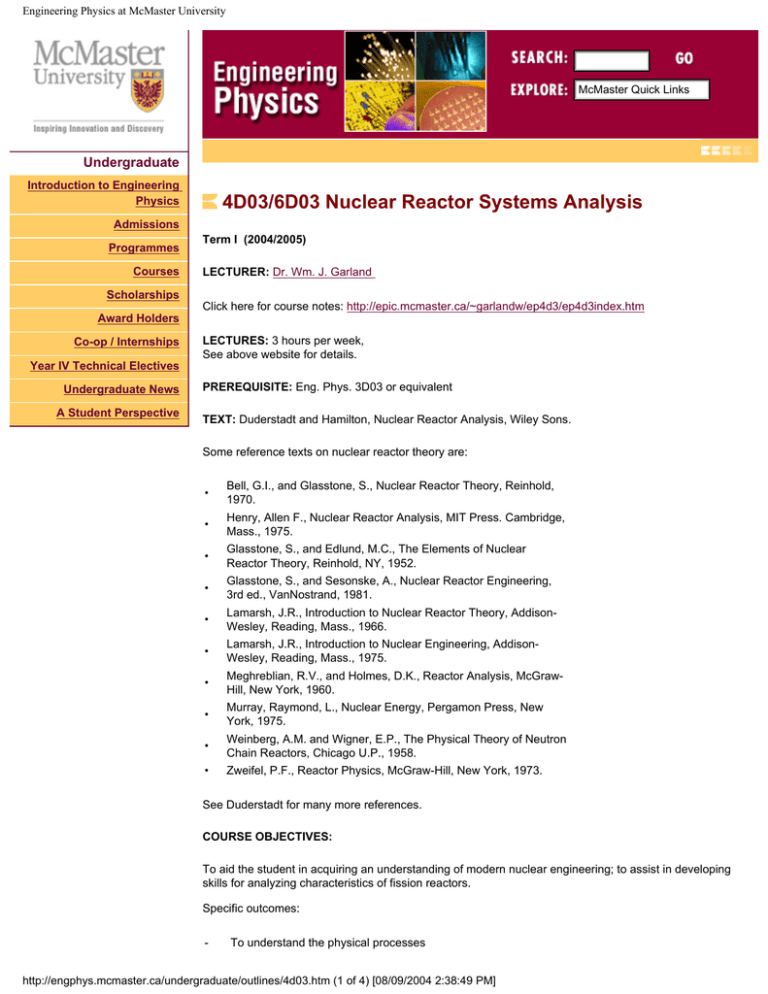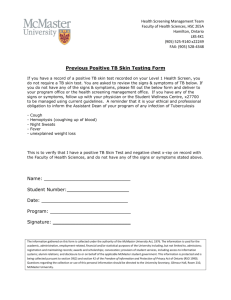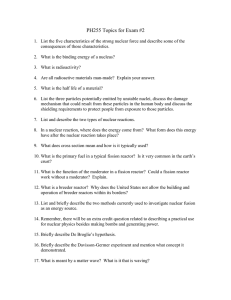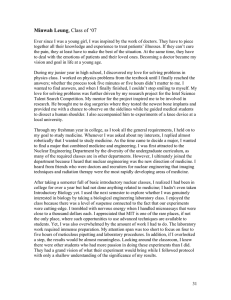Engineering Physics at McMaster University
advertisement

Engineering Physics at McMaster University McMaster Quick Links Undergraduate Introduction to Engineering Physics 4D03/6D03 Nuclear Reactor Systems Analysis Admissions Programmes Courses Term I (2004/2005) LECTURER: Dr. Wm. J. Garland Scholarships Click here for course notes: http://epic.mcmaster.ca/~garlandw/ep4d3/ep4d3index.htm Award Holders Co-op / Internships LECTURES: 3 hours per week, See above website for details. Year IV Technical Electives Undergraduate News A Student Perspective PREREQUISITE: Eng. Phys. 3D03 or equivalent TEXT: Duderstadt and Hamilton, Nuclear Reactor Analysis, Wiley Sons. Some reference texts on nuclear reactor theory are: • Bell, G.I., and Glasstone, S., Nuclear Reactor Theory, Reinhold, 1970. • Henry, Allen F., Nuclear Reactor Analysis, MIT Press. Cambridge, Mass., 1975. • Glasstone, S., and Edlund, M.C., The Elements of Nuclear Reactor Theory, Reinhold, NY, 1952. • Glasstone, S., and Sesonske, A., Nuclear Reactor Engineering, 3rd ed., VanNostrand, 1981. • Lamarsh, J.R., Introduction to Nuclear Reactor Theory, AddisonWesley, Reading, Mass., 1966. • Lamarsh, J.R., Introduction to Nuclear Engineering, AddisonWesley, Reading, Mass., 1975. • Meghreblian, R.V., and Holmes, D.K., Reactor Analysis, McGrawHill, New York, 1960. • Murray, Raymond, L., Nuclear Energy, Pergamon Press, New York, 1975. • Weinberg, A.M. and Wigner, E.P., The Physical Theory of Neutron Chain Reactors, Chicago U.P., 1958. • Zweifel, P.F., Reactor Physics, McGraw-Hill, New York, 1973. See Duderstadt for many more references. COURSE OBJECTIVES: To aid the student in acquiring an understanding of modern nuclear engineering; to assist in developing skills for analyzing characteristics of fission reactors. Specific outcomes: - To understand the physical processes http://engphys.mcmaster.ca/undergraduate/outlines/4d03.htm (1 of 4) [08/09/2004 2:38:49 PM] Engineering Physics at McMaster University - To understand and be able to write down the basic equations - To be able to solve the basic equations To be able to simulate a reactor/source configuration as appropriate depending on: - # of dimensions - steady state or transient - # of groups - delayed precursors - space dependent properties and grid spacing OUTLINE: Introduction to nuclear energy; nuclear physics and chain reactions; reactor statics and kinetics; multi-group analysis; fuel management. A detailed course outline and schedule is given in a separate document. PROBLEM ASSIGNMENTS: (a) Normally problem assignments will be set via the web at intervals of one week. They will be assigned after the appropriate material has been covered in the lectures, if possible. (b) Problem sets are due by the end of the lecture one week after being assigned, unless otherwise specified. Assignments will be reviewed in class if necessary. (c) Marking: Marked sets will be returned within one week of submission. If the problem set is not turned in by the dead-line, the mark given will be zero. If the marked problem set is not returned within one week after submission, the mark assigned will be 100. If you expect to miss an assignment for any reason or if you miss for reasons of ill health, you must inform the lecturer as soon as possible to avoid penalty. (d) Format: If your solutions are not legible they will not be marked; please use one side of a page only. Draw a solid line at the end of each problem solution. Order the problems in the same way they are assigned. Remember if the marker has to spend five to ten minutes deciphering what you have submitted, he or she has that much less time to assist you by indicating your errors. (e) Adjustments: We are not infallible. If an error has been made in marking, consult the marker or lecturer for an adjustment. (f) Solutions: Solutions to problem sets will be posted on the web soon after the assignment is due. For obvious reasons, no late assignments will be accepted once the solutions are posted. ASSISTANCE WITH COURSE WORK AND PROBLEMS: The instructor will be available to assist you with the lecture material or problems. Times will be arranged in class. TERM TESTS AND QUIZZES: During the term there will be one term test (~45 minutes). There will also be at least one short quiz (~15 minutes). These will be conducted in regular lecture periods. Solutions will be posted on the web after the test/quiz lecture period. FINAL EXAM: There will be a 3 hour final examination for the entire course during the December examination session. It will be based on material covered by the lectures, assignments, test and quizzes. Example exams and solutions are available on the web. The exam will be closed book but crib sheets are permitted (3 double sided or 6 single sided 8 ½ " x 11" sheets). There is no restriction on the use of a calculator. FINAL COURSE MARK: http://engphys.mcmaster.ca/undergraduate/outlines/4d03.htm (2 of 4) [08/09/2004 2:38:49 PM] Engineering Physics at McMaster University (a) The final mark will be based on three components: (i) problem assignments during the term; (ii) term tests and quizzes; (iii) final test or examination. (b) The three components are weighted so as to maximize the student's mark based on his performance. The following table lists all possible weighting combinations (in percent): Assignments Test & Quizzes Examination 30 10 60 20 10 70 30 30 40 20 30 50 (c) The weighting scheme was developed with the following criteria in mind: (1) The final mark will consist of no less than 40% examination mark. (2) It is possible to pass the course based on the term work alone. Up to 60% of the final mark can be from the term work. (3) The assignment component is obtained by simply averaging the number of assignments involved. If an assignment is not received, a zero is included when calculating the average. The weight ratio of one test to one quiz is 3:1. (4) A computer is used to keep track of the marks and marking procedure. Interim results will be available at regular intervals. FORECAST OF THE FINAL MARK: Soon after the mid-term, a projection of final marks will be made based on performance to that time and assuming an exam mark identical to the mid-term. This will be updated periodically as more marks become available. If a student has a forecast final mark of less than 50%, it is suggested that he/she seek advice as quickly as possible from the lecturer. COLLUSION: In the past, groups of students have tended to collaborate and discuss assignments. This is acceptable in moderation. However, the final submitted assignments must be a student’s individual work, not a copy of someone else’s solution. The course marker is instructed to watch carefully for any evidence of copying. If the marker suspects copying, he/she will mark the relevant papers normally, but will make a special notation on the paper and the marking sheet. The marks of these students will not be entered until they have discussed the assignments with the lecturer. If copying has taken place, all students involved will receive zero for that assignment. POLICY REMINDERS: Academic dishonesty consists of misrepresentation by deception or by other fraudulent means and can result in serious consequences, e.g. the grade of zero on an assignment, loss of credit with a notation on the transcript (notation reads: "Grade of F assigned for academic dishonesty"), and/or suspension or expulsion from the university. It is your responsibility to understand what constitutes academic dishonesty. For information on the various kinds of academic dishonesty please refer to the Academic Integrity Policy, specifically Appendix 3, located at http://www.mcmaster.ca/senate/academic/ac_integrity.htm The following illustrates only three forms of academic dishonesty: 1. Plagiarism, e.g. the submission of work that is not one's own or for which other credit has been obtained. 2. Improper collaboration in group work. 3. Copying or using unauthorized aids in tests and examinations. The Faculty of Engineering is concerned with ensuring an environment that is free of all adverse discrimination. If there is a problem that cannot be resolved by discussion among the persons concerned, individuals are reminded that they should contact their Department Chair, the Sexual Harassment Officer or the Human Rights Consultant, as soon as possible. http://engphys.mcmaster.ca/undergraduate/outlines/4d03.htm (3 of 4) [08/09/2004 2:38:49 PM] Engineering Physics at McMaster University Contact Us | Legal & Privacy Policy http://engphys.mcmaster.ca/undergraduate/outlines/4d03.htm (4 of 4) [08/09/2004 2:38:49 PM]




